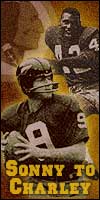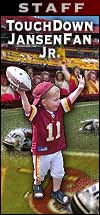The Bears defense in 1963 allowed just 10.3 points per game, and 144 points overall, the lowest total in 13 years. Chicago led the NFL in a rare triple, finishing number one against the run, pass and overall. Working under Halas, defensive coordinator George Allen installed a double zone pass defense that puzzled opposing offenses, beginning with the two-time defending champion Packers in the season opener an Sept. 15 in Green Bay. The Chicago defense, which led the league in interceptions with 36, the most by any NFL team in the 1960s, picked off four Bart Starr passes and held the powerful Packer offense to 73 yards passing and just 150 yards of total offense in a 10-3 Bears' win.
The key to the defense was the double zone constructed by Halas and Allen. When Halas returned to coaching in 1958 after a two-year absence, he introduced the "BUZ" defense. In his autobiography, Halas said BUZ was a code word for the Bears' new zone defense. The "B" stood for the linebackers in the 4-3; the "U" instructed them to move closer to the line to confuse enemy quarterbacks, and the "Z" told the 'backers to drop into coverage at the start of the play and help the secondary against the pass, and told the defensive ends to flare out to cover running plays.
Halas also introduced a color-coded system of linebacker blitzes. "Red dog" was the blitz signal for the right linebacker; "White dog" was the middle linebacker's blitz call; and "Blue dog the right linebacker's call.
Allen said the BUZ defense was designed to get the Chicago linebackers into hook and flat zones as quickly as possible. The BUZ proved particularly effective against screens and draws, as the linebackers dropped into coverage, keying on the quarterback and aided by instructions from safeties Richie Pettibon and Roosevelt Taylor.
Taylor led the league in interceptions with nine, and he, Pettibon, defensive end Doug Atkins, and linebackers Bill George and Joe Fortunato made the all-pro team. The front four was bookended by the 6-8 Atkins and Ed O'Bradovich, with Stan Jones and Fred Williams at the tackles. Larry Morris joined George and Fortunato at linebacker, and Whitsell and Bennie McRae started at the corners.
After beating the Packers in the regular season opener, the Bears reeled off seven wins in their next eight games. On Nov. 17, they met Green Bay in a rematch at Wrigley Field. Both teams were 8-1, and the winner would be in control in the Western Division standings. The Packers were hurting, having lost halfback Paul Hornung to a one-year gambling suspension and Starr to a broken hand. Still, Allen succeeded in crossing up Green Bay head coach Vince Lombardi with an unorthodox defensive twist.
While most NFL teams played a straight 4-3, with the defensive tackles lining up on the outside shoulders of the offensive guards, Allen designed an "odd" formation that presented backup QB Zeke Bratkowski with a five-man look. While "odd" and "even" defenses had been used in pro football before, Allen took the "odd" formation one step further. The Bears confused Green Bay's veteran linemen by shifting from one "odd"look to another before the snap of the ball. Chicago would move from an overshifted defense to the left to an undershift to the right, with tackles Stan Jones and Earl Leggett alternately going head-up on center Jim Ringo. With Green Bay's blocking schemes confused, the Bears won easily, 26-7.
This is a snip from a long article guessing how a Super Bowl would have been played out in January, 1964, between the Bears and the Chargers.
For a Redskins fan, interesting for the mentions of George Allen, defensive coordinator of the Bears, and Pichie Petibon, their strong safety.
http://www.footballresearch.com/article ... chargers63


